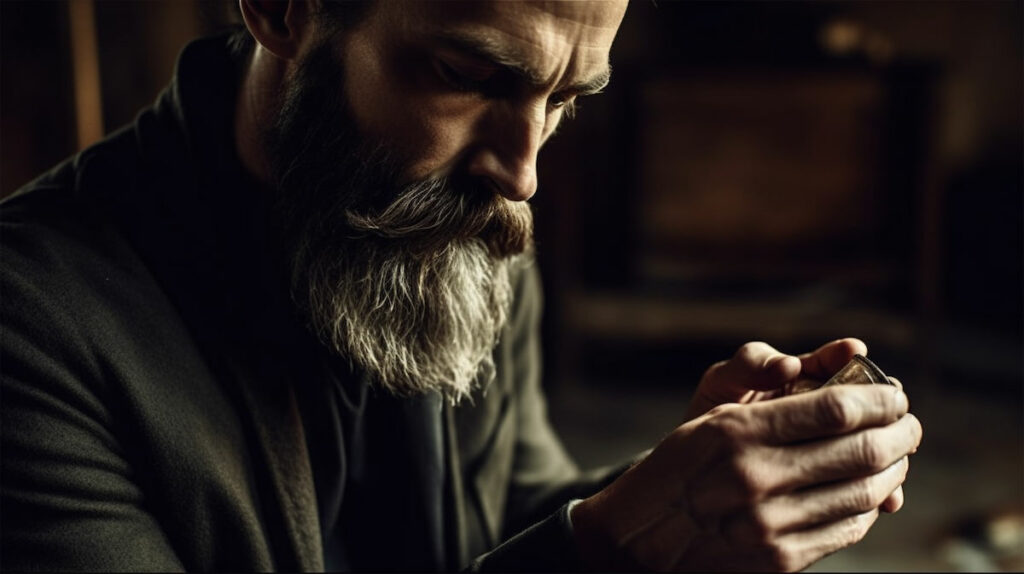
Maintaining a well-groomed beard is essential in today’s fashion world. No doubt, a well-groomed beard can enhance personality, but does that mean subjecting it to the same dye formulas as our hair? In this article, we will discuss the question that plagues many men – Can You Use Hair Dye on Your Beard?
Understanding the Differences Between Hair and Beard
Before discussing whether hair dye can be used on beards, it is essential to understand the differences between hair and beard. While they may seem similar, there are significant differences in their structure and growth patterns.
Hair Structure and Growth
Hair grows from the epidermal layer of the skin called the follicle. The hair is made of keratin protein, which gives it its properties, texture, and color. Hair on the head is typically longer, finer, and more delicate than beard hair.
The density and thickness of hair vary depending on various factors such as genetics and hormones that regulate hair growth. Interestingly, hair on the head will grow at a rate of about 0.5 inches per month, while beard hair grows at a slightly slower rate of 0.3 inches per month.
Beard Texture and Thickness
Beard hair, as opposed to hair on the head, is coarser, drier, and curlier in texture. The follicles that produce beard hair are more sensitive to external factors like heat and cold, which can cause the hair to become brittle and prone to breakage.
Additionally, beard hair varies in density over different face areas. For example, the chin and mustache areas tend to be denser than the cheeks or neck. The thickness of beard hair varies from person to person, and they tend to grow at different rates depending on age and ethnicity.
For example, Asian men tend to have thinner and sparser beards than their Caucasian or African American counterparts.
Color Retention and Fading
Hair dye formulas can penetrate the cuticle layer on the hair shaft. Once the pigment from the dye adheres to the hair shaft, it mimics the regular hair color by reflecting the light. Hair dye fades, over time, as hair continues to grow because the chemical composition of the hair pigments changes due to exposure to different environments.
Beard hair, in contrast, tends to hold dyes for a more extended period because they grow slower, and we do not wash our beards multiple times daily as compared to our head hair. However, it is important to note that beard hair can still fade over time due to exposure to sunlight and other environmental factors.
Overall, while hair and beard may seem similar, they have distinct differences in their structure, texture, and growth patterns. Understanding these differences is essential when considering whether to use hair dye on your beard.
Types of Hair Dyes and Their Suitability for Beards
Beards have become a popular trend among men in recent years, and many men want to experiment with different beard styles and colors. Hair dye is one of the ways to achieve a new look for your beard, but it’s essential to choose the right type of hair dye that suits your skin and hair type.
In this section, we’ll discuss the different types of hair dyes and their applicability to beards.
Permanent Hair Dyes
Permanent hair dyes are harsh chemicals that can penetrate the hair shaft and alter the natural hair color. They are commonly used for coloring hair on the head, but they should not be used on beards as they can cause skin irritation and hair damage due to their strong bind with the hair shaft.
The harsh chemicals in permanent hair dyes can cause the skin underneath the beard to become red, itchy, and irritated. It’s essential to avoid using permanent hair dyes on your beard to prevent any skin or hair damage.
Semi-Permanent Hair Dyes
Semi-Permanent hair dyes do not use ammonia, and instead of depositing pigments on the hair shaft’s surface creating a colored coating on the hair. They are suitable to use for beards as they are gentle, and the color tends to fade over time.
Semi-permanent hair dyes are a great option for those who want to try out different colors without the commitment of a permanent dye. However, the color may not be as vivid as with other types of hair dyes.
Temporary Hair Dyes
Temporary hair dyes are suitable for occasional use as they leave pigment only on the hair cuticle surface and gradually fade away with every wash. Temporary hair dye is an ideal option for people who want to try hairstyles or hair colors for a short period.
They are also suitable for those who want to experiment with different colors without committing to a permanent or semi-permanent dye. Temporary hair dyes come in various forms, including sprays, gels, and powders.
Natural and Organic Dyes
Natural and Organic Dyes are becoming increasingly popular due to their non-toxic and non-reactive nature. They are suitable for beards as they do not have harsh ingredients that can damage the skin or hair shaft and provide a natural, subtle look. Natural and organic dyes come in different forms such as henna, coffee, and indigo, among others.
Henna is a popular natural dye that is made from the leaves of the henna plant. It’s a great option for those who want to achieve a reddish-brown color for their beard. Coffee is another natural dye that can be used to darken the beard’s color, while indigo can be used to achieve a blue-black color.
Before using any hair dye on your beard, it’s essential to perform a patch test to ensure that you are not allergic to the ingredients. It’s also crucial to follow the instructions on the hair dye package carefully to avoid any skin or hair damage.
How to Safely Dye Your Beard
Are you tired of your beard’s natural color? Do you want to add some flair to your facial hair? Dyeing your beard is a great way to switch things up and add some personality to your look. However, it’s essential to do it safely and correctly to avoid any adverse effects.
In this guide, we’ll walk you through the steps to safely dye your beard.
Preparing Your Beard for Dyeing
Before applying dye to your beard, it’s crucial to prepare it adequately. First, clean and trim your beard hair to remove any dirt, oil buildup, or split ends. Use a beard shampoo that’s specifically designed for facial hair.
Waiting for a few days after shaving will ensure that the skin underneath has healed. Avoid exposing your beard to heat, such as hot showers or hair dryers, to prevent skin irritation.
Additionally, consider using a beard conditioner to soften the hair, making it easier to apply the dye evenly. A soft beard will also help the dye penetrate the hair shaft better, resulting in a more vibrant and long-lasting color.
Choosing the Right Color and Dye Type
Choosing the right dye color and type is crucial to achieving your desired look. Consider your natural hair color and choose a shade that complements it. If you’re unsure, consult with a professional stylist or colorist.
Semi-permanent, natural, and organic dyes are suitable for a subtle and natural look, while temporary hair dyes are ideal for an adventurous approach. Perform a patch test before applying the dye to your beard to check for any allergic reactions to the dye’s components.
Step-by-Step Beard Dyeing Process
Now that you’ve prepared your beard and chosen the right dye color and type, it’s time to start the dyeing process. Here’s a step-by-step guide:
- Wear gloves to protect your skin from the dye.
- Apply petroleum jelly on the skin surrounding the beard to help avoid accidental staining.
- Mix the dye according to the package instructions.
- Apply the dye evenly using a brush or applicator, starting at the roots and working your way down to the tips.
- Leave the dye on for the recommended time, usually between 10 and 30 minutes.
- Rinse the dye off with lukewarm water and beard shampoo until the water runs clear.
It’s essential to follow the instructions on the dye package carefully. Leaving the dye on for too long can cause skin irritation or damage to your beard hair. On the other hand, washing the dye off too soon can result in a patchy or uneven color.
Aftercare and Maintenance
After dyeing your beard, it’s crucial to take proper care of it to maintain the color and prevent any adverse effects. Here are some tips:
- Avoid swimming, sauna, or dust exposure for the first few days after dyeing.
- Avoid exposure to heat and direct sunlight, as they can cause the color to fade or change.
- Keep your beard hydrated using natural, oil-based beard products, such as beard oil or balm.
- Avoid using harsh chemicals or alcohol-based products that can strip the dye and cause dryness or damage to your beard hair.
By following these steps and tips, you can safely and effectively dye your beard and achieve the look you desire. Remember to take your time, follow the instructions carefully, and take good care of your beard afterward.
Potential Risks and Side Effects of Using Hair Dye on Beards
Like any other cosmetic practice, using hair dye on facial hair comes with potential risks and side effects. Here are the risks and side effects of using hair dye on beards.
Skin Irritation and Allergic Reactions
The primary risk of beard dyeing is allergic reactions on the skin. The dye components can cause skin irritation, rashes, or itching. Perform a patch test before applying the dye on your beard to see any potential reactions.
Uneven Color and Patchiness
If the dye too thickly, the color may not apply evenly, causing patchy spots on the beard. To avoid this, apply an even layer of dye or adjust the texture to prevent any lumps or bumps.
Damage to Beard Hair and Skin
Harsh chemicals like ammonia and other strong oxidizing agents can damage beard hair, making it dry and prone to breakage. These chemicals can cause skin irritation, redness, and soreness, leading to patchy beard hair and scarring.
Conclusion
In summary, using hair dye on beards can be done safely by using the appropriate dye formulas, performing patch tests, and precautions such as cleaning the beard and using suitable dye types. However, proper aftercare and maintenance are essential to avoid damage to the beard hair and skin. Finally, always track your reaction to the dye, its longevity, and any other parameters to make an informed decision.

Todd
Caffeinated Beard Enthusiast, Family Man & Dog Lover. Hailing from the picturesque landscapes of Salt Lake City, Utah, Todd Harris is a devoted husband, loving father, and proud dog owner with a passion for all things coffee and facial hair. His dynamic personality and unmistakable love for life are evident in each of his engaging blog posts.
